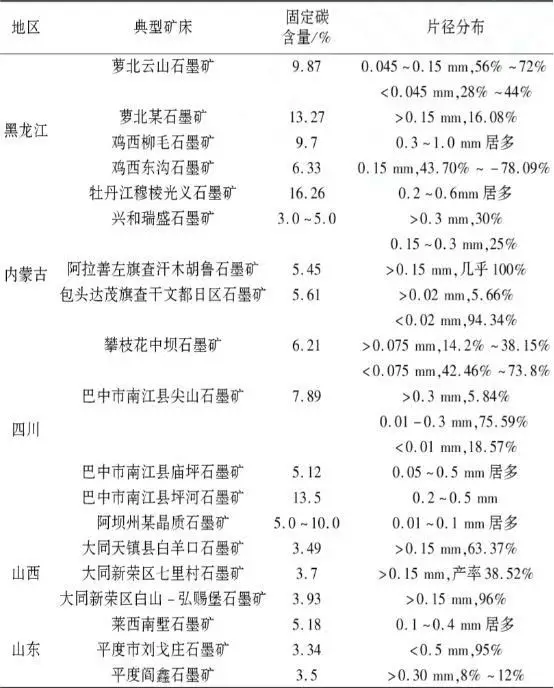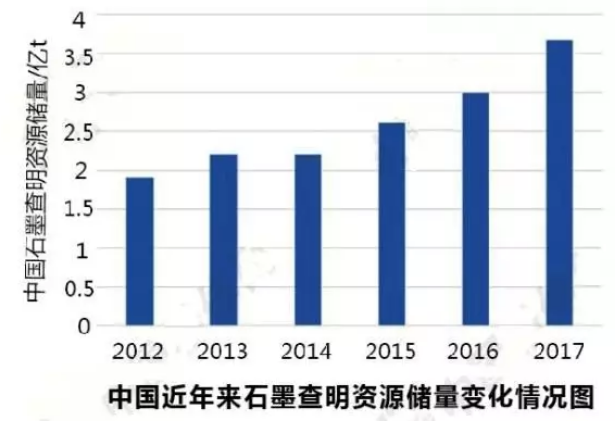Graphite is a crystal of carbon, a non-metallic material with a silvery gray color, soft texture and metallic luster. Natural graphite can be divided into scaly graphite and massive graphite which are well-crystallized. Natural graphite has excellent properties and can be used to produce natural graphite electrodes, battery carbon rods and brushes, graphite crucibles, graphite cathodes and other products. It is widely used in modern industrial production.
There are three main types of graphite deposits in China:
1 regional metamorphism (for example, Heilongjiang Jixi Liumao, Liaoning Huanren, Inner Mongolia Xinghe, Shandong Lai Southwest Villa, Henan Recital, Sichuan Panzhihua Zhongba, Yunnan Yujie, Hubei Yichang Sancha, Jiangxi Jinxixia Mountain, Xinjiang Sulubezhen and Yuquanshan, etc.).
2 contact metamorphosed type (for example, Jilin meteorite, Hunan Lutang, Jiangxi Changshouyuan, etc.).
3 Assimilation mixed type (for example, Xinjiang Yuli Tokbulak, Xinjiang Qitai Sujiquan and Huangyangshan).
These three types of graphite deposits are post-production deposits rebuilt from organic-rich strata.

China has abundant graphite ore resources, but its ash is too high, which affects its use in the carbon industry. The data shows that at present, China has identified 360 million tons of graphite mineral resources, of which the reserves of crystalline graphite mineral resources are nearly 300 million tons. The crystalline graphite is mainly distributed in Heilongjiang, Inner Mongolia, Sichuan, Shanxi and Shandong provinces. Among them, Heilongjiang identified 12,884,800 tons of resource reserves, accounting for 43%; Inner Mongolia, 82.026 million tons, accounting for 27%; Sichuan, 20.95.43 million tons, accounting for 7%; Shanxi, 19.5622 tons, accounting for nearly 7%; Shandong 1619.11 Ten thousand tons, accounting for 5%, the five provinces identified about 89% of the country's resources, and the other regions accounted for about 11%.

With the standardization of the development of China's natural graphite industry, the production cost of primary products has increased, coupled with the strict inspection of environmental protection, which has restricted the production of deep-processed products, especially the purification of graphite, which has become a bottleneck restricting the development of natural graphite industry in some places.
However, China's economic restructuring is improving, and graphite is gradually turning to new energy and new materials. The application trend is obvious, including the consumption of conductive materials (lithium batteries, fuel cells, etc.), oil additives and fluorine graphite. Increase, it is expected that this proportion will exceed 25% in 2020.
Therefore, China's natural graphite market has more and more imported natural graphite. Domestic natural graphite enterprises have begun to purchase overseas graphite powder in batches, or directly mine graphite mines overseas. According to statistics, in 2017, the import volume of phosphorus flake natural graphite in China was 5,482.50 tons, an increase of 433.47% compared with the same period of last year. In 2018, the import volume of natural flake graphite in China reached 60,253.734 tons, which was an increase compared with the same period of last year. 999.03%.
Iso4161 Hexagon Flange Nuts,Customized Hexagon Flange Nuts,Stock Of Hexagon Flange Nuts,Company Of Hexagon Flange Nuts
Chuangtuo Jinggong (Jiangsu) Co., LTD , https://www.chtofastener.com